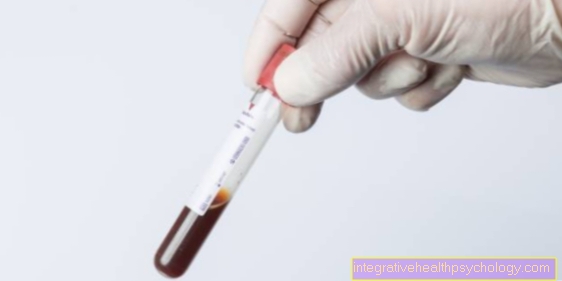Operation of a lipoma
introduction
A lipoma is a benign tumor that originates in the body's fat cells.
In most cases (99%) the lipomas grow just below the skin, so they are often bothersome. Most lipomas are very small and their size is in the millimeter range. Sometimes they can also be very large, up to 20cm.
The most common locations for lipomas are the neck, upper arms, lower legs, spine and abdomen. In principle, however, it can develop anywhere where there is fatty tissue, for example in organs or in the abdominal cavity. A lipoma usually does not cause symptoms such as pain or the like. If lipomas occur in large numbers in a person, one speaks of lipomatosis, which can often be genetic.

When will the operation be performed?
A lipoma in and of itself is harmless because it is a benign tumor and usually does not cause pain. In some cases, however, the lipoma presses on blood vessels or nerves and restricts their function, so that secondary symptoms develop. The patients then often feel a tingling sensation, numbness, for example in an extremity, or pain caused by the compression of the nerve (see: Pain in a lipoma). Localization of the lipoma in areas of particular stress / friction, such as in the area of the joints, the armpit or in the neck in the area of the shirt collar, is also critical.
Read more on the subject at: Symptoms of a lipoma
Also surgically removed are lipomas that have a high growth tendency and lipomas for which benignity has not been confirmed with certainty. After all, you can only decide whether it is benign or malignant one hundred percent after an operation by examining it under the microscope. Malignancy must be ruled out, especially in the case of rough tactile findings, as lipomas are usually soft and movable. A malignant differential diagnosis to a lipoma is, for example, the liposarcoma, which also arises from fat cells.
Another reason for surgical removal of a lipoma is for cosmetic reasons. Depending on the location and size, the small to large nodules are often perceived by those affected as unattractive and stressful, which is why they want to have them removed. Removal for purely cosmetic reasons is not covered by the health insurance.
Read more on this topic at: General treatment for a lipoma or Swelling on the side of the neck
Performing the operation

Depending on the size of the lipoma the operation takes place under local anesthesia. In the case of larger lipomas, there is sometimes one general anesthetic instead of. The operation only takes a few minutes because it is a small surgical procedure. With the scalpel, the surgeon makes a small incision in the skin and takes it Tissue capsulethrough which the Lipoma is enclosed, and sews up the small skin incision again. The removal of the lipoma is usually relatively easy, since the lipoma is not caked with its surroundings like a malignant tumor, for example. In contrast to a malignant tumor, there is no safety margin to healthy tissue must be followed to ensure that all tumor cells are also removed.
Is it a large lipoma or a muscular lipoma, a lipoma that is not below the skin, but rather below the muscle grows, general anesthesia may be necessary. The typical capsule formation of the lipoma is beneficial during the operation, since it causes the tumor can be removed as a whole without the risk of tumor cells remaining. After the operation, the lipoma will be sent for examination laboratory sent in to ensure that the tissue does not contain any malignant cells.
An alternative to surgery is the Liposuction (Liposection). The surgeon injects a liquid into the lipoma through a small incision in the skin, which liquefies the fatty tissue so that the lipoma can be suctioned off. In contrast to surgery, this method does Risk that not all cells of the lipoma will be caught and these remaining cells will continue to proliferate can. Another disadvantage of the liposuction procedure is that the material cannot be easily examined by the pathologist for malignancy, since the cells are usually already destroyed. Even if you choose to have surgery to remove the lipoma, there is a risk that it will return to you Relapse comes, so possibly a operated on for the second time must become.
Duration / sick leave
The surgery in itself only lasts a few minutesbecause it is a very minor procedure. Then a Printing compound applied to avoid bleeding. The affected area should also be immobilized briefly in the initial phase. How quickly you will be fit again after the operation depends primarily on whether you have a local anesthesia was applied or a general anesthetic.
After a local anesthetic, stay there briefly for observation to see whether there are any intolerances to the anesthesia, otherwise no restrictions apply.
Became a general anesthetic carried out, you will remain under observation for a few hours after the procedure, after which you can be discharged home. With general anesthesia, however, you should no longer drive your car on the day of the procedure, but rather let yourself be picked up. During the day another increased tiredness and exhaustion consist.
A Sick leave beyond the day of the operation is usually not necessary. However, it became a larger lipoma removed or a work with heavy physical strain is performed, a Sick leave for two to three days respectively. This is always one individual decision. A few days after the operation, a check-up will take place at the family doctor, who will check the healing process of the wound and pull the threads.
Surgery for a lipoma of the shoulder
The shoulder is a common site of lipoma. In approximately twelve percent one of the cases is a lipoma on the shoulder. In the shoulder area, that is above all shoulder blade a predestined position. Since there are many joints in the shoulder area, this can often cause disorders there, which is why one surgical removal usually makes sense is. Carrying bags / rucksacks also often causes friction in the shoulder area, which is why the lipoma can also be bothersome. Also cosmetic Reasons for a lipoma removal are often in the foreground in the shoulder area.
Cost of lipoma removal
Is the removal of the lipoma medically indicated, for example if the lipoma is on a annoy presses, then the costs will be covered by the respective health insurance. However, if it is a surgical removal from purely cosmetic Reasons, the costs must be borne by the patient himself. The costs are approx 140 € per lipoma. The costs also depend on whether the procedure is under local anesthesia or under general anesthetic takes place.
Does the health insurance company pay for the lipoma removal?
It is impossible to say with certainty whether every health insurance company will cover the cost of removing a lipoma.
However, the stronger the need for removal, the higher the chances are.
For example, if the lipoma is causing further discomfort because it may be pressing on a nerve, thereby restricting the feeling or even movement of a part of the body, there is a clear indication for treatment.
However, since lipomas can also be very inconspicuous and harmless, the health insurance company may not cover the costs.
cure
The healing process after an operation is relatively uncomplicated and brief.
It is a small operation that only requires a small incision, which is why the organism is little affected and the healing process is completed very quickly.
If signs of inflammation such as fever, redness, swelling or pain are found in the area of the wound, it is important to see a doctor.
What will the scar look like after lipoma removal?
Nowadays it is possible to remove even large lipomas with the help of very small incisions in the skin.
The smaller the cut, the better the skin heals.
What the scar looks like after such an incision depends on the size and, above all, the location of the skin incision.
It is generally the case that a more beautiful cosmetic result can be achieved if the doctor has the opportunity to cut along the so-called skin split lines. But everyone is also different in their way of forming scars.
The results of the same procedure can look different for different people.
What is the follow-up treatment after the operation?
Since in the best case only a skin suture remains after the removal of a lipoma, there is no concept for aftercare.
Care should be taken to ensure that the skin can heal well and does not become infected during this.
Plasters or bandages are used for this in the first few days.
If the lipoma has previously caused other symptoms, such as pain or sensory disturbances due to pressure on a nerve, you should check whether these symptoms have improved as a result of the procedure.
Can you remove the lipoma without surgery?
In addition to the usual surgical method of removing a lipoma, there is now an alternative.
Some doctors offer to treat lipomas with so-called "fat-path injections".
The mechanism of lipolysis is used here.
This means that the fat that ultimately makes up the lipoma is dissolved.
The downside to this approach is that it leaves the lipoma capsule in the body.
It can still only be completely removed by surgery.





























